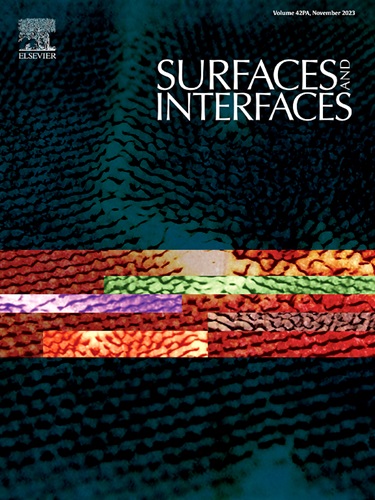Reduction of particle agglomeration through mechanochemical-surfactant propped nanomicelles formation in Zinc Oxide exploring the enhanced photocurrent density of quasi solid dye-sensitized solar cells
IF 5.7
2区 材料科学
Q2 CHEMISTRY, PHYSICAL
引用次数: 0
Abstract
Our study has successfully developed a distinctive zinc oxide nanostructure using a simple mechanochemical technique. The nanostructure's surface reveals the presence of micelles, which are formed due to functionalization with cetyltrimethylammonium bromide surfactant. A thorough examination was conducted to determine the thermal stability of the materials. We discovered that specific samples experienced degradation of the micelle structure after being subjected to a thermal treatment at 400 °C. The degradation resulted in the formation of spherical nanoparticles. The powder X-ray diffraction pattern and Fourier transform infrared spectral measurements indicate that the zinc oxide nanomaterials possess a wurtzite phase. At the same time, their surface exhibits a micelle-like structure due to the adsorption of cetyltrimethylammonium bromide in the SZO1 and SZO2 samples. The FT-IR measurements were conducted for functional group identification and to confirm the formation of surface micelles on the zinc oxide surface. The changes in the zeta potential and polydispersity values indicate the formation of surface micelles well. The surface features and particle size were analyzed using scanning electron microscopy and transmission electron microscopy techniques. The achieved particle size was approximately 10–14 nm, and the initial observation of micelle structures in the SZO1 and SZO2 particles was not sustained after thermal treatment. The absorption spectra of the SZO3 samples reveal the presence of extended absorption edges, which can be attributed to the random arrangement of spherical particles and the notable surface roughness. Incorporating SZO1 and SZO2 in the dye-sensitized solar cell devices significantly improved photocurrent density, resulting in an impressive power conversion efficiency of approximately 4.5 %. The findings of this study have improving solar cell performance, and highlighting a promising approach to enhancing solar cell performance. MATLAB simulation and photochemical studies further supported the device performance based on the micelle-structured zinc oxide photoanode. This paper meticulousness. It presents a comprehensive analysis of photocurrent enhancement and power conversion efficiency, demonstrating the meticulous approach of our study. This enhancement results from the alteration of cetyltrimethylammonium bromide, creating structures resembling micelles on the surface. The promising results of our study offer hope for the future of solar cell technology and its potential for commercialization.

求助全文
约1分钟内获得全文
求助全文
来源期刊

Surfaces and Interfaces
Chemistry-General Chemistry
CiteScore
8.50
自引率
6.50%
发文量
753
审稿时长
35 days
期刊介绍:
The aim of the journal is to provide a respectful outlet for ''sound science'' papers in all research areas on surfaces and interfaces. We define sound science papers as papers that describe new and well-executed research, but that do not necessarily provide brand new insights or are merely a description of research results.
Surfaces and Interfaces publishes research papers in all fields of surface science which may not always find the right home on first submission to our Elsevier sister journals (Applied Surface, Surface and Coatings Technology, Thin Solid Films)
 求助内容:
求助内容: 应助结果提醒方式:
应助结果提醒方式:


